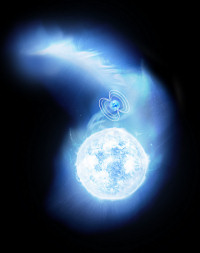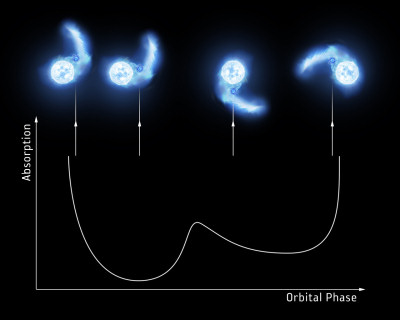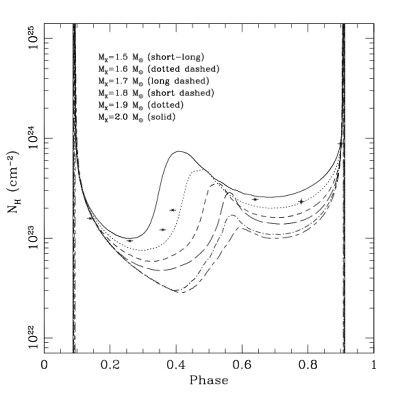Astronomers develop new method to determine neutron star mass
9 November 2012
Astronomers have used INTEGRAL and XMM-Newton to look into the neutron star in IGR J17252-3616, a highly obscured X-ray binary system. The data show how the neutron star, which is being fuelled by the stellar wind from its companion, is substantially deflecting the flow of the accreted material. Comparison with numerical simulations provides an estimate of the neutron star's mass, suggesting a new method to determine the mass of these extremely dense, exotic objects. |
| Artist's impression of a neutron star in a highly obscured high-mass X-ray binary system. Credit: ESA/AOES Medialab |
Neutron stars are created at the end of a massive star's life from the gravitational collapse of the stellar core. They are among the most dense objects in the Universe and provide astronomers with marvellous laboratories to explore the physics of matter at extremely high densities.
An important factor to constrain the properties of matter in such exotic environments, which are still largely unclear, is the mass of neutron stars. Astronomers have determined the mass of about 60 neutron stars so far, and most of them seem to have masses around 1.4 times the mass of the Sun. Only a handful neutron stars are known with masses around two solar masses, well below the upper limit prescribed by the theory, which is 3.2 solar masses. Astrophysicists are keen to find massive neutron stars.
A study based on observations from two ESA missions – INTEGRAL and XMM-Newton – as well as on numerical simulations, has now provided a new method to determine the mass of neutron stars that may have the potential to unveil a few massive ones in the future.
"To estimate neutron star masses, we look at the ones that are part of binary stellar systems because, in a binary system, the relative motions of the two components are determined by their masses," explains Antonios Manousakis, who led this study.
"In this case, we looked at a special type of binary system: an X-ray binary, where the neutron star is accreting mass from its companion star. In these systems, the accreted material is heated up to millions of degrees and emits large amounts of X-rays," he adds.
Manousakis undertook this research as a PhD student under the supervision of Roland Walter at the ISDC Data Centre for Astrophysics at the University of Geneva, Switzerland. He is currently a researcher at the Nicolaus Copernicus Astronomical Center in Warsaw, Poland.
The binary system investigated in this study, known as IGR J17252-3616, belongs to a special class of sources named highly obscured high-mass X-ray binaries. In a high-mass X-ray binary (HMXB) system, the companion star fuelling the accreting neutron star is a bright, massive star. Highly obscured HMXBs are a subset of these systems that exhibit very faint emission at soft X-ray energies: as a result had eluded all searches in this portion of the electromagnetic spectrum. They were discovered via hard X-ray observations with INTEGRAL in 2003.
"We believe that soft X-rays from highly obscured high-mass X-ray binaries are absorbed by the wind released by the neutron star's companion, a supergiant star," notes Chris Winkler, INTEGRAL project scientist at ESA. "On the other hand, hard X-rays are not affected by the stellar wind, making these sources easier to spot in hard X-rays," he adds.
Manousakis and his collaborators made use of extensive observations of the hard X-ray emission from IGR J17252-3616 obtained with INTEGRAL, which monitored this source frequently over the past decade. In addition, XMM-Newton was also used to obtain dedicated observations of the soft X-ray emission from this source.
"Although highly obscured HMXBs are intrinsically fainter at soft X-rays, they can still be detected with XMM-Newton. In particular, the observations of the soft X-ray emission from this binary system were crucial to reveal variations in this absorbed component," comments Norbert Schartel, XMM-Newton project scientist at ESA.
 |
| Variations in the absorption of the soft X-ray emission from an eclipsing, highly obscured high-mass X-ray binary as a function of its orbital phase. Credit: ESA/AOES Medialab |
The astronomers were able to gather more information about the dynamics of this system because IGR J17252-3616 is an eclipsing binary: the inclination of the orbital plane with respect to our line of sight is such that the two components are seen to periodically transit in front of one another.
"The occurrence of eclipses allows us to tackle the dynamics of this binary system by studying how much the soft X-ray emission is absorbed by the stellar wind as the neutron star and its companion move around one another," notes Roland Walter of the Data Centre for Astrophysics (ISDC) at the University of Geneva, Switzerland.
"The variations we observed in the XMM-Newton data exhibit a regular pattern that shows us how the stellar wind is being deflected by the neutron star's gravity," Walter adds.
| The stellar wind is deflected by the neutron star's gravity in a numerical simulation of highly obscured HMXB. Courtesy of Antonios Manousakis, ISDC, Geneva, Switzerland. Click here for more information on this video. |
The team of astronomers tried to reproduce this behaviour using numerical simulations. In particular, they looked at how the density and shape of the accreted material evolve in highly obscured HMXBs with different values for the velocity of the stellar wind and the mass of the neutron star.
"The simulations we ran show that binary systems with slower stellar winds are more likely to develop streams and trailing tails in the proximity of the neutron star. These features could cause absorption variations such as those seen in IGR J17252-3616," explains co-author John Blondin from North Carolina State University at Raleigh, USA. "This seems to suggest that slow stellar winds and highly obscured HMXB are somehow correlated."
The simulations also showed that the mass of the neutron star plays an important role in shaping the observed variations in the absorption. More massive neutron stars induce a more pronounced deflection on the flow of accreted matter. This results into a thicker and denser tail that trails the neutron star, causing stronger absorption.
"The dependence of the absorption variations on the neutron star's mass in the simulations suggests that we can use this approach to estimate the mass of neutron stars in this type of system. In the case of IGR J17252-3616, the comparison between simulations and observations suggests that the neutron star hosted in this binary system is a rather massive one, with a mass of about 1.9 solar masses," says Manousakis.
 |
| Absorption variations and neutron-star masses in highly obscured high-mass X-ray binaries. Credit: From Manousakis et al, 2012 |
This value, determined by using the flow of accreted matter as a test particle to trace the neutron star's gravitational field, is in agreement with previous estimates of this object mass based on independent measurements.
The method proposed in this study provides an independent and robust alternative to currently used techniques to assess the mass of these exotic objects, proving a fruitful synergy between two missions in ESA's Science Programme.
Notes for editors
The study presented here is based on observations of the highly obscured high-mass X-ray binary IGR J17252-3616, an eclipsing binary system where a neutron star is accreting matter from a supergiant blue star.
The hard X-ray emission from IGR J17252-3616 was monitored extensively with ESA's INTEGRAL space observatory, yielding a regular survey of the source's variability over the past decade. These data were combined with additional observations from NASA's Rossi X-Ray Timing Explorer to constrain the orbital parameters of the binary system. Besides, 10 dedicated observations of the soft X-ray emission from IGR J17252-3616 were obtained with ESA's XMM-Newton X-ray space observatory. The XMM-Newton data were used to study in great detail how much the soft X-rays are absorbed by the stellar wind as a function of the binary system's orbital phase.
The data have then been compared with the predictions from numerical simulations performed using the freely-available hydrodynamical code VH-1, which is maintained at North Carolina State University by Prof. John Blondin.
INTEGRAL is an ESA project with instruments and science data centre funded by ESA Member States (especially the Principal Investigator countries: Denmark, France, Germany, Italy, Spain, Switzerland) and Poland, and with the participation of Russia and the USA.
The European Space Agency's X-ray Multi-Mirror Mission, XMM-Newton, was launched in December 1999. It is the biggest scientific satellite to have been built in Europe and uses over 170 wafer-thin cylindrical mirrors spread over three high throughput X-ray telescopes. Its mirrors are among the most powerful ever developed. XMM-Newton's orbit takes it almost a third of the way to the Moon, allowing for long, uninterrupted views of celestial objects. The scientific community can apply for observing time on XMM-Newton on a competitive basis.
Contacts
Antonios Manousakis
ISDC Data Centre for Astrophysics
Observatoire de Geneve, Switzerland
and Nicolaus Copernicus Astronomical Center
Warszawa, Poland
Email: antonism camk.edu.pl
camk.edu.pl
Phone: +48 223 296 101
Roland Walter
ISDC Data Centre for Astrophysics
Observatoire de Geneve, Switzerland
Email: Roland.Walter unige.ch
unige.ch
Phone: +41 22 379 21 28
John M. Blondin
Dept. of Physics, North Carolina State University
Raleigh, NC, U.S.A.
Email: blondin ncsu.edu
ncsu.edu
Phone: +1-919-515-7096
Chris Winkler
INTEGRAL Project Scientist
Research and Scientific Support Department
Directorate of Science and Robotic Exploration
ESA, The Netherlands
Email: cwinkler rssd.esa.int
rssd.esa.int
Phone: +31-71-5653591
Norbert Schartel
ESA XMM-Newton Project Scientist
Directorate of Science and Robotic Exploration
European Space Agency
Email: Norbert.Schartel esa.int
esa.int
Phone: +34-91-8131-184




